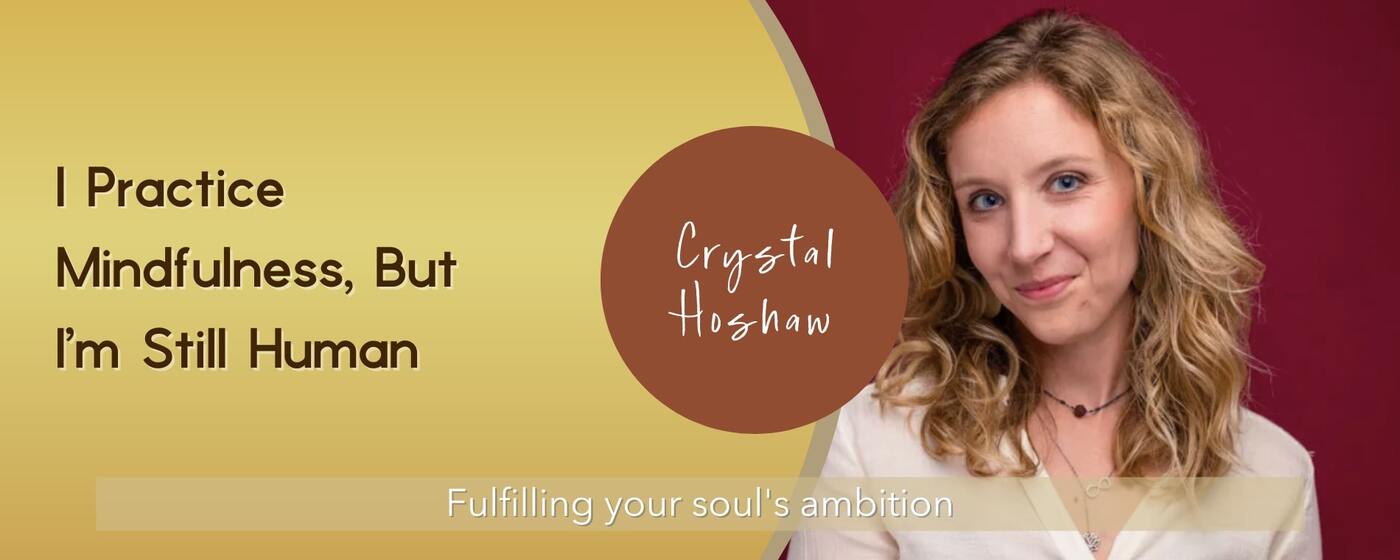
I Practice Mindfulness, But I’m Still Human
Sometimes I catch myself saying that I started practicing yoga and mindfulness when I was fourteen. While this is true, I don’t mean to say that I’ve been practicing consistently since then.
There have been huge swaths of my life where practice fell to the wayside completely.
Let me just out myself right now; I’m no exemplar of being in the present moment at all times.
I’ve had to set myself back on the path over and over, often after pretty significant deviations. This is true both in life and in practice.
These setbacks have served to show me where I’m really at, what I’m really working with, and what areas still need growth and attention.
I often explain meditation as being like a record player. The awareness is the needle, and the grooves in the record are the thoughts. The practice of meditation is taking the needle and resetting it at the center of the record over and over and over.
Inevitably, as the record spins, the needle makes its way to the edge. The practice is to continually, softly, gently, and with a sense of humor, bring the needle back to center.
That’s about it.
Sounds easy enough, but those thoughts can be really, really distracting.
Practicing Beginner’s Mind
There are a few reasons I’ve never graduated to what I’d call an “advanced” meditator.
Admittedly, one is that I have a pretty hard time sitting for very long. Meditation takes patience, and it must be cultivated over time. Still working on that.
The other, more positive reason is that when we approach meditation from a beginner mindset over and over, we come with a fresh perspective without conceptions. We come without the ego trip that we’re gaining something, getting somewhere, or becoming something that would warrant the label “advanced”.
This helps to infuse the practice with humility and prevent spiritual bypassing, or skipping over the hard stuff.
Every time we practice mindfulness, we are bringing with us a brand new set of circumstances, emotions, and mental states to sit with. Sometimes our meditation feels breezy, calming, and rejuvenating.
Other times, even the idea of sitting is uncomfortable. It’s sitting in the moments of discomfort that helps us learn to be with what is. But being with what is doesn’t always feel good, and that’s okay too.
Sticking With It
We can take comfort in the fact that our mindfulness practice doesn’t have to be “good” every time we sit. In fact, removing these labels entirely is part of letting go of mental conceptions.
What’s really important in practice is consistency. That’s what will train us to be with what is, no matter the outer circumstances. This is what creates resilience and self-possession.
I’ve gone through periods of life when my meditation practice was solid and regular, three times a day. I could see the effect of this in every aspect of my life. I was less reactive, more patient, had a better sense of humor, let things roll off me, was more effective in my work, had more empathy to share with others…you get it.
Then some life change came my way, and I started practicing a little less. Or not at all.
For a while, the effects of mindfulness still linger. But just like our strength wanes when we don’t keep up a fitness routine, our mindfulness muscles start to fade. Then we find ourselves back in our old patterns as if we had never practiced at all.
The good news is that our practice doesn’t disappear entirely. The reality of brain plasticity is that, yes, we can slide back. But when we recommit and get back on the horse, so to speak, those grooves that we dug during the time that we did practice are still there, and we can find them again.
Tips For Staying On Track
- Be realistic. How often and for how long can you realistically practice so that you can be consistent? Don’t set yourself up to fail by scheduling three practices a day right off the bat. Start with small goals that you know you can reach. Then you’ll be empowered to keep going when you hit them.
- Be honest. When are you skipping practice because you really have to, and when are you doing it because there is something more interesting to do? There are going to be times when we have to use our willpower to make the choice to stick to our plan, and those are the times that our commitment is really tested. When you choose to practice instead of following distraction, you are strengthening your resolve. The reward is so much greater than what your FOMO is telling you you’re missing.
- Be regular. My yoga and meditation teachers always say that frequency, intensity, and duration are the factors that determine how deep you go in anything, whether it’s meditation, learning a new sport, or honing a skill.
- Keep a sense of humor. Don’t give yourself a grade for your practice. Keep it focused but light. I like to imagine my awareness as a mother cat gently bringing her escaping kittens back to their basket. It’s pretty hard to be mad at a rogue kitten. Just like kittens, the nature of the mind is to be wayward. Just keep gently bringing yourself back, and don’t take it too seriously.
Mindfulness Is Kindness
The most important thing that mindfulness teaches us is to have compassion for ourselves and others. If you are harsh and critical toward yourself, it’s inevitable that you will be harsh and critical toward others – even if it’s only subconscious.
Mindfulness helps us polish the lens through which we see the world. If that lens is one of judgment, mindfulness helps us become more accepting. If that lens is one of victimization, mindfulness helps us see the kindness and generosity in others. If that lens is one of not-belonging, mindfulness helps us see that we are part of the human family.
When we let go of these conceptions, we behave in ways that embody acceptance, kindness, and belonging rather than their contracted opposites.
When we extend the same compassion toward ourselves that we would toward a friend, a pet, or a child, we are embodying the true attitude of mindfulness. Not only that, but we’re acknowledging our interconnectedness with the rest of the world.
Mindfulness, ultimately, is a tool to help us become more human. That starts with how we treat ourselves.


